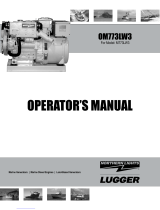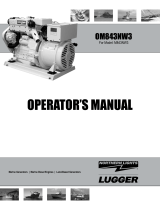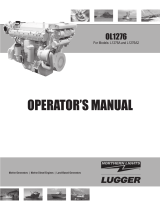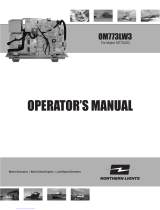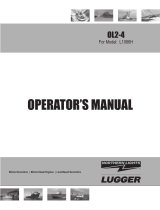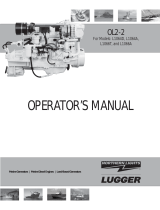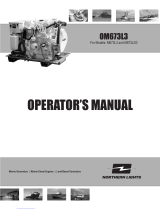Page is loading ...

O844K
For Models: M844K, M844LK, M20CL, and M20CR
OPERATOR’S MANUAL
Marine Generators | Marine Diesel Engines | Land-Based Generators

Diesel engine exhaust and some of its constitu-
ents are known to the State of California to cause
cancer, birth defects, and other reproductive harm.
— CALIFORNIA —
Proposition 65 Warning:
Northern Lights
4420 14th Avenue N.W.
Seattle, WA 98107
Tel: (206) 789-3880
Fax: (206) 782-5455
Copyright ©2009 Northern Lights, Inc.
All rights reserved. Northern Lights™, and
the Northern Lights logo are trademarks of
Northern Lights, Inc.
Printed in U.S.A.
PART NO.: O844K 10/09

O844K 10/09
Read this operator's manual thoroughly before starting to operate your equipment.
This manual contains information you will need to run and service your new unit.
1
Proprietary Information
This publication is the property of Northern Lights, Inc.
It may not be reproduced in whole or in part without the written permission of Northern Lights, Inc.
© Northern Lights, Inc. All rights reserved. Litho U.S.A. Publication number O844K 10/09
OPERATOR'S MANUAL
for Models
M844k, M844Lk, M20CL, and M20CR
Table of Contents
INTRODUCTION ...................................................... 2
Models Included ................................................... 2
Model Numbers .................................................... 2
Serial Numbers ..................................................... 3
WARRANTY ............................................................ 3
SAFETY RULES ...................................................... 3
COMPONENT LOCATIONS
M844k and M844Lk Marine Generators .............. 4
M20CL Marine Generators ................................... 5
CONTROL PANELS
Northern Lights Generator Sets ............................ 6
OPERATING PROCEDURES
Break-in Period ..................................................... 8
Before Starting ...................................................... 8
Starting .................................................................. 8
Operating .............................................................. 8
Stopping ................................................................ 8
Shutdowns and Alarms ......................................... 9
Spare Parts ............................................................ 9
SERVICING SCHEDULE CHART ............... 10 - 11
SERVICING
Lubrication - General ..........................................12
Checking Oil .......................................................12
Oil Changes ........................................................12
Changing Oil Filter .............................................12
Air Filter .............................................................13
SERVICING (continued)
V-Belts ................................................................13
Retightening Cylinder Head Bolts ......................13
Valve Clearances .................................................13
Fuels - General ....................................................14
Fuel Filters ..........................................................14
Bleeding the Fuel System ...................................15
Injector Service ...........................................16 - 17
Injection Pump ....................................................17
Cooling System - General ...................................17
Cooling System Flushing ....................................18
Heat Exchanger (Marine) ...................................18
Raw Water Pump ................................................18
Generator Ends ...................................................18
Electrical System - General ................................18
Glow Plugs ..........................................................19
Booster Batteries .................................................19
Battery Care ........................................................19
PTO Care ............................................................19
Winterizing / Out-of-Service ..............................19
TROUBLESHOOTING
Electrical .............................................................20
Engine .........................................................21 - 23
DATA SHEETS
M844k .................................................................24
M844Lk ..............................................................25
M20CL ................................................................26
WIRING DIAGRAMS
DC Electrical ......................................................27

O844K 10/09
Introduction
2
Unit Identication
Servicing of marine engines and generator sets presents
unique problems. In many cases boats cannot be moved
to a repair facility. Marine engines cannot be compared
to the servicing of automobiles, trucks or even farm
equipment. Failures often occur in remote areas far
from competent assistance. Marine engines are taxed
far more severely than auto or truck engines; therefore,
maintenance schedules must be adhered to more
strictly.
Failures can begin with minor problems that are over-
looked and become amplied when not corrected during
routine maintenance.
As operator, it is your obligation to learn about your
equipment and its proper maintenance. This is not a
comprehensive technical service manual. Nor will it
make the reader into an expert mechanic. Its aim is to
aid you in maintaining your unit properly.
L, C
MODELS INCLUDED
This manual covers the operating instructions for:
M844k marine generator sets,
M844Lk marine generator sets, and
M20CL commercial generator sets.
NOTE: There are two versions of the 844 engine. The standard engine is designated 844. The long-stroke engine
is designated 844L. You will need to know which engine you have to use this manual and to order parts.
Fill in the model number of your unit in the blank space provided.
This will give you a reference whenever service or maintenance is required:
L - Long stroke version
C - Commercial version
+
+
Northern Lights marine diesel generator set with
an 844 engine and a PX-300K generator end.
M 844
=
M844k
Northern Lights marine diesel generator set with
an 844L engine and a PX-300K generator end.
=
M844Lk
Northern Lights 20 kW (@ 60 Hz) commercial grade
marine generator set with a special generator end.
=
M20CL
Model number of engine block
Bore Cylinders
84 mm 4
M - Northern Lights marine generator set
Model Numbers
Model numbers give the unit's application, block model, aspiration, and RPM:
My Northern Lights generator set MODEL number is:

O844K 10/09
Serial Numbers
3
Safety Rules
CAUTION: This symbol is used throughout
this book to alert you to possible danger areas.
Please take special notice of these sections.
A warranty registration certicate is supplied
with your set. It entitles the original purchaser of our
equipment to a warranty covering material
or assembly faults. The extent of coverage is described
in the Limited Warranty Statement. We recommend
that you study the statement carefully.
NOTE: If the warranty is to apply, the servicing
instructions outlined in this manual must be
followed. If further information is needed, please con-
tact an authorized dealer or the factory.
CAUTION: Accident reports show that careless use of engines causes a high percentage of accidents.
You can avoid accidents by observing these safety rules. Study these rules carefully and enforce them on the job.
• Never leave engine without proper security.
• Turn the coolant tank cap slowly to relieve pressure
before removing. Add coolant only when the engine
is stopped and cool.
• Mount a re extinguisher near engine.
• Always disconnect the battery ground strap before
making adjustments.
• Operate engines in properly ventilated areas.
• Keep trash and other objects away from engine.
• Escaping uids under pressure can penetrate your
skin. Use a piece of cardboard or wood, not your
hands, to search for leaks.
• Avoid wearing loose clothing without a belt when
working around engines.
• Do not oil or grease engine while it is running.
• Use caution in handling fuel. Never refuel a hot
or running engine. Do not smoke while lling fuel
tank or servicing fuel system.
Your set has three serial numbers:
an engine number stamped
on the block,
a generator plate, and
a generator set plate.
Use the serial number on the generator set plate when ordering parts
or in correspondence. The generator set plate is found on the service
side of the generator and resembles the drawing in Figure 1.
Fill in the serial number of
your unit in the box provided.
Figure 1: Generator set serial number plate.
Warranty
• Keep your hands, feet, hair and clothing away from
power-driven parts.
• Check for any loose electrical connections or faulty
wiring.
• Engines should be operated only by knowledgeable,
qualied personnel.
• Look completely around engine to make sure that
everything is clear before starting.
• Do not operate an engine that isn't in proper work-
ing order. If an unsafe operating condition is noted,
tag the set and control panel so others will also
know about the problem.
• Provide rst aid kits.
My Northern Lights generator set SERIAL number is:

O844K 10/09
1. Coolant Fill
2. Expansion Tank/Exhaust
Manifold/Heat Exch.Tank
3. Coolant Drain
4. Wet Exhaust Elbow
5. Junction Box
6. Vibration Mount
7. Starter
8. Coolant Thermostat (behind)
9. Belt Guard
10. Raw Water Pump
11. Alternator
12. Water Temperture Sender
13. DC Circuit Breaker
14. Secondary Fuel Filter
15. Fuel Return Line
16. Crankcase Vent
17. Fuel Injector
18. Oil Fill (Top)
19. Fresh Water Pump
20. Injection Pump
21. Oil Fill (Side)
22. Raw Water Inlet
23. Oil Pressure Sender
24. Freshwater Block Drain
25. Fuel Return Line
26. Fuel Inlet Line
Figure 2A and 2B: M844K and M844LK with PXK generator ends.
Marine Generator Component Locations
4
27. Oil Dipstick
28. Oil Filter
29. Lube Oil Drain
30. Control Panel Plug-in
31. Fuel Lift Pump
32. AC Circuit Breaker for
Automatic Voltage Regulator
33. PTO (Optional)
Non-Service Side
a
Service Side
Optional PTO
a

O844K 10/09
8. Vibration Mount
9. DC Alternator
10. Keel Cooler Return
11. Water Temperature Sender
12. Oil Pressure Switch
13. Coolant Fill
14. Fuel Injector
15. Fresh Water Pump
16. Injection Pump
17. Oil Fill (Side)
18. Freshwater Block Drain
19. Oil Dipstick
20. Oil Filter
21. Fuel Inlet
22. Lube Oil Drain
23. Control Panel Plug-in
24. Generator End
25. DC Circuit Breaker
26. Secondary Fuel Filter
27. Fuel Lift Pump
28. Fuel Return Line
29. Crankcase Vent
30. Oil Fill (Top)
Figure 3A and 3B: M20CL with special generator end.
1. Air Filter
2. Coolant Thermostat (behind)
3. Expansion Tank/Manifold/
Heat Exchanger Tank
4. Coolant Drain
5. Manifold End Caps (2)
6. Junction Box
7. Starter
Commercial Generator Set Component Locations
5
Non-Service Side
Service Side
a
a

O844K 10/09
Control Panels
6
Figure 4-B: Series 3 Generator Control Panel
Figure 4-A: Series 1-B Generator Control Panel
Figure 4-C: Series 4 Generator Control Panel
1. SHUTDOWN BYPASS-PREHEAT SWITCH
Two functions are built into this switch: the preheat-
ing of the engine, and bypassing of the engine safety
shutdown circuit. Hold switch in the ON position
10 - 20 seconds before starting the engine, and continue
holding on during engine cranking. Release the switch
as soon as the engine is running. Holding the switch on
too long can burn out the heater element.
2. ENGINE CONTROL SWITCH
To start the engine, hold this switch in the START posi-
tion until the engine is running.
NOTE: Excessive cranking of marine sets equipped
withwaterliftmufersystemscancauseenginedamage.
See page 10.
After the engine starts, release the switch and it will
return to RUN position. To stop the engine, hold the
switch in the STOP position until the engine has com-
pletely stopped.
NOTE: The rocker switch is used on Series 1 panels
only, and has a light that glows when the set is running.
3. HOUR METER
Keeps track of engine running time.
4. OIL PRESSURE GAUGE
Shows the oil pressure in the engine lubricating system.
5. ENGINE TEMPERATURE GAUGE
Registers the temperature of the engine coolant.
6. D.C. VOLTMETER OR AMMETER
When the engine is stopped, the voltmeter indicates the
condition of the battery. When the engine is running, the
voltmeter indicates the voltage output of the alternator.
For Series 4 Control Panels Only:
7. A.C. VOLTMETER
Shows the generator output voltage.
8. FREQUENCY METER (Hertz)
The frequency meter indicates alternating current fre-
quency: 60 Hz (1800 RPM), or 50 Hz (1500 RPM).
9. AMMETER/VOLTMETER SELECTOR SWITCH
Used to check voltage and current of each phase.
10. A.C. AMMETER
Shows the generator load on each phase. The phase is
selected with the Ammeter Selector switch (Item 9).

O844K 10/09
7
Notes

O844K 10/09
8
BREAK-IN PERIOD
1. The rst 100 hours on a new or reconditioned
engine are critical to its life and performance.
2. Frequently check the engine temperature and oil
pressure gauges (sets with Series 3 or 4 panels).
3. Oil consumption is greater during break-in as
piston rings take time to seat.
4. Break-In Oil Changes: Change engine oil and
lter at 50 hours. Change oil and lter again at
100 hours (consult Lubricants section for oil recom-
mendation).
Operating Instructions:
Maintain at least a 75% load on your generator
set for the rst 100 hours. If this is not possible,
maintain no less than a 50% load to ensure proper
seating of the piston rings. Vary the load to help
seat the rings.
BEFORE STARTING
1. Check the water level by removing the pressure
cap from the expansion tank or radiator. In order to
give the cooling water an opportunity to expand, the
level should be about 1 in. (2.5 cm) below the ller
cap sealing surface when the engine is cold.
CAUTION: Use protective clothing and open the
ller cap carefully when the engine is warm to
prevent burns.
2. Check the oil level in the crankcase with the dip-
stick. The oil level must be in the wafed area on the
stick. Never allow the level to go below this area.
Always add the same viscosity of oil as is already in
the crankcase.
3. Check the fuel tank level and open any fuel valves.
4. Marine Sets: close the sea-cock; check, clean, and
reassemble the sea strainer and re-open the sea-cock.
5. Marine Sets: place the battery switch in the ON posi-
tion.
6. NOTE: The battery switch must always be kept
ON while the engine is running. If the switch is
turned OFF while the engine is running, the bat-
tery charging regulator could be ruined.
STARTING
1. Hold the Shutdown Bypass-Preheat switch in the ON
position for 10 to 20 seconds before starting a cold
engine. Holding the switch too long can burn out the
glow plugs. This step is not necessary if the engine is
already warm.
2. While holding the Shutdown Bypass-Preheat switch
in the ON position, push the Engine Control switch
to the START position.
3. As soon as the engine starts, release both switches. Do
not crank the starter for more than 20 seconds consecu-
tively. If the engine fails to start with the rst attempt,
be sure that it has stopped completely before re-engag-
ing.
6.
NOTE: Excessive cranking of the starter on Marine
sets equipped with a water lift mufer can cause
engine damage. If the engine does not start after three
20-second cranks, remove the impeller from the raw
water pump. This will prevent the mufer from lling
with water and backlling the exhaust line and engine.
Once the engine starts, shut it off immediately and
re-install the impeller. Re-start the engine and check
the exhaust overboard outlet for gushes of water.
OPERATING
1. Units with Series 3 and Series 4 Control Panels:
check gauges often. Oil pressure must be above 15
PSI. The D.C. voltmeter should read between 11
and 15 volts at 80°F (25°C) ambient temperature.
The water temperature gauge on Marine sets must
be below 200°F (94°C). Check the A.C. voltage
and frequency meters (Series 4 panel). If the gauges
deviate from normal levels, shut down the generator
set and investigate.
2. Let the unit run unloaded for a three to ve minute
warm-up period.
3. Apply electrical load.
STOPPING
1. Remove electrical load from the generator set.
2. Run the engine for a 3 to 5 minute cool down period.
3. Hold the Engine Control switch to the STOP posi-
tion until the engine comes to a complete stop.
4. Marine Sets: shut off the seacock, fuel valve, and
battery switch.
Operating Procedures

O844K 10/09
9
SHUTDOWNS AND ALARMS
1. Your unit is tted with a system to protect it from
high water temperature or low oil pressure.
a. Generator sets have shutdown systems to stop the
engine. They have no warning horns.
b. Other alarms and shutdowns are available as
optional equipment.
NOTE: Do not rely on your warning to the exclu-
sion of careful gauge monitoring. Watching your
gauges can prevent damage to the unit and danger-
ous power losses.
2. Do the following when your warning or shutdown
system is activated:
a. Check the temperature gauge.
Marine sets: If above 205°F (96°C), shut off the
engine immediately.
b. Use the Trouble Shooting Guide on page 22 to
isolate the cause of the overheat.
CAUTION: Do not remove the water ll
cap of an overheated engine. Escaping high
temperature steam can cause severe burns. Allow
the engine to cool and then remove the cap slowly
using protective clothing.
d. Make repairs. Restart your Marine set after the
temperature gauge registers below 200°F (94°C).
e. Watch the temperature gauge regularly and
turn off the unit if the temperature rises
above 205°F (96°C) on Marine units.
Repeat troubleshooting.
3. If shutdown is activated and the temperature gauge
shows temperature within normal temperature range:
a. Check the engine crankcase oil level.
b. If the oil level is low, ll with recommended
lubricating oil and restart. Watch the oil pressure
gauge carefully and shut off the engine if it does
not show a normal reading (20-60 PSI) after a
few seconds of operation.
c. If the oil level is normal, DO NOT restart the
engine. Call your dealer for assistance.
SPARE PARTS
1. Northern Lights recommends that you keep the
following spare parts on hand for eld service. The
parts are available from your local Northern Lights
dealer.
Some marine models already have “On-Board-Kits,”
a handy box that contains the most common parts
you will need.
2. All owners should have the following spares:
a. Primary and secondary fuel lter elements
b. Oil lters
c. Air lter
d. Alternator belt
e. Thermostat and gaskets
f. Seawater pump impeller & gaskets (marine only)
g. Glow plug
h. Injector and washer
3. If your set is operating a long distance from a servic-
ing dealer, add the following:
a. Complete set of injectors
b. Copper washers for injector change
c. Complete set of glow plugs
d. Fuel lift pump
Operating Procedures

O844K 10/09
The Servicing Schedule Chart below shows the service schedule required for proper maintenance of your generator
set. More detailed coverage of each Service Point (SP) is listed on the page noted in the ‘page’ column.
DAILY:
SP1 Check oil level in engine
SP5
Check V-belt tension
SP7 Check primary fuel lter
SP13 Check coolant level
Check sea strainer (marine only)
Check raw water pump for leaks
SP18 Check electrolyte in batteries
AFTER FIRST 50 HOURS:
SP2/3 Change engine oil and lter
SP6
Adjust valves
AFTER FIRST 100 HOURS:
SP2/3 Change engine oil and lter
EVERY 250 HOURS:
SP3 Change lube oil lters
SP4 Check air cleaner
SP19 Check state of charge of batteries
EVERY 500 HOURS:
SP8
Change primary fuel lter element
SP9
Change secondary fuel lter
SP22 Inspect condition of exhaust elbow
EVERY 1000 HOURS:
SP4 Change air cleaner element
SP6
Check valve clearances
SP11 Check injectors
SP17 Change impeller
EVERY 2500 HOURS:
SP12
Check fuel injection pump
SP14 Check and ush cooling system
SP15 Check and clean heat exchanger
1) Perform all maintenance once a year even if hour level has not been reached.
2) Consult manufacturer's maintenance schedule, note on chart.
3) Whenever necessary.
4) More often if necessary.
5) Afterrst50hours,thenat100hours,thenatevery250hours.
6) Change air cleaner element at 1000 hours.
Servicing Schedule Chart
10
SERVICE 50 250 500 1000 2500
POINT PAGE OPERATION DAILY Hours Hours Hours Hours Hours
ENGINE:
SP1 8 & 12 Check oil level •
SP2 12 Change engine oil 1) 5) • •
SP3 12 Changelubeoillters 1)5)
• •
SP4 13 Check air cleaner 1) 4) 6) •
SP5 13 Check V-belt tension
•
SP6 13 Check valve clearances 1) 2)
•
FUEL SYSTEM:
SP7 14 Checkprimarylter(Racor) 2)3) •
SP8 14 Changeprimarylterelement(Racor) 2)3) •
SP9 14 Changesecondaryfuellter 1)3) •
SP10 15 Bleed the fuel system 3)
SP11 16 - 17 Check injectors 1) 3)
•
SP12 17 Check fuel injection pump •
COOLING SYSTEM:
SP13 8 & 17 Check coolant level •
SP14 17-18 Checkandushcoolingsystem 1)4) •
SP15 18 Check and clean heat exchanger •
SP17 18 Change impeller in raw water pump 1) 3) •
SP22 Inspect condition of exhaust elbow 4) •
ELECTRICAL SYSTEM:
SP18 19 Check electrolyte level in batteries •
SP19 19 Check condition of batteries with hydrometer 1) 4) •
DRIVEN EQUIPMENT:
SP20 19 Clutch and PTO service 2)
OUT OF SERVICE:
SP21 19 Winterizing or out-of-service 3)

O844K 10/09
Service Record Notes
11

O844K 10/09
Servicing
LUBRICATION - GENERAL
1. Use only clean, high quality lubricants stored in
clean containers in a protected area.
2. These lubricants are acceptable:
a. API Service CC/CD/CE single viscosity oils.
b. API Service CC/CD/SF multi-viscosity oils.
3. Use the proper weight oil for your average opera-
tion temperature.
Figure 5: Lube Oils
4. Some increase in oil consumption may be
expected when SAE 5W and SAE 5-20W oils are
used. Check oil level frequently.
5. Never put additives or ushing oil in crankcase.
SP1. CHECKING OIL LEVEL
1. Check the oil level in the crankcase with the dip-
stick. The oil level must be in the wafed area
on the stick. Never allow the level to go below
this area. Follow the lubrication recommendations
above.
SP2. OIL CHANGES
1. The set is delivered with special break-in oil.
Change the engine oil and oil lter after 50 hours
of operation. Use Service CC 30 weight oil during
the rst 100 hours.
2. Change the oil and lter again at 100 hours using the
oil recommended in the above diagram. After this,
change oil and lter every 250 hours.
3. During intermittent cold weather operation, change
oil every 100 hours or six weeks, whichever comes
rst.
4. Change oil at the end of each season and the begin-
ning of each season.
5. Change oil when engine is warm.
6. Dispose of waste oil in an approved manner.
7. Never use a ushing oil.
8. Loosen the clamp on the oil change tube. Remove
cap. Drain oil. Replace the cap and tube.
9. Rell engine with recommended oil for the season.
10. Engine capacity with new oil lter is:
844k and 844Lk – 2.1 gallons (8.2 liters)
SP3. CHANGING LUBE OIL FILTER
1. Change the lube oil lter every 100 hours.
2. Use a lter wrench to remove old lter. Dispose of
lter in approved manner.
3. Make sure the gasket from the old lter is removed
and discarded. Clean mount face.
4. Spread a thin lm of engine oil on the rubber gasket
on the new lter and screw it on nipple until gasket
meets the sealing surface.
5. Using hands only – no wrench – tighten lter
one-half turn farther. Overtightening can do
damage to lter housing.
6. Fill engine with recommended oil. Start engine and
check for leakage. Stop engine, wait 3 minutes, and
check oil level. Add additional oil if necessary.
7. Oil lter part number is:
844k and 844Lk – #24-03100
Air Single Multi-
Temperature Viscosity Viscosity
Above 32°F
SAE 30W SAE 15-40W
(0°C)
-10 to 32°F
SAE 10W SAE 10-30W
(-23 to 0°C)
Below -10°F
SAE 5W SAE 5-20W
(-23°C)
12

O844K 10/09
SP4. AIR CLEANER
1. Inspect air cleaner every 250 hours. In dusty condi-
tions, check more often.
2. Marine sets: if dirty, wash element in soapy water.
Rinse and dry thoroughly before re-installing.
Replace if necessary. Part numbers are:
M844k and M844Lk – #24-23100
3. C-Series sets: the element cannot be cleaned.
Replace it when necessary. Part number is:
M20CL – #24-28401
4. NOTE: Make absolutely sure no impurities enter
the engine while changing the element. Do NOT
run the engine with the air cleaner removed.
SP5. V-BELTS
1. Check the tension and wear on the V-belt daily.
2. Use your thumb to press on the belt at the midpoint
between the crankshaft and alternator pulleys. The
tension is correct if the belt can be depressed about
3/16 in. (5 mm).
Servicing
Figure 8: Valve Adjustment
SP6. VALVE CLEARANCES
1. Adjust valve clearance after rst 50 hours of opera-
tion and every 1000 hours thereafter.
2. Valve adjustments should be done after the cylinder
head bolts have been re-tightened. Engine should be
cold and NOT running.
3. Watch the valves while turning the engine over by
hand. Turn until the inlet valve starts to open and the
exhaust valve starts to close (the valves are rock-
ing). Then turn the crankshaft one more full turn and
adjust the clearance on both valves for this cylinder.
4. Loosen the lock nut and adjust the clearance between
the rocker arm and valve guide of both the intake
and exhaust valves with the adjustment screw (Figure
8). Clearance on both intake and exhaust valves
should be 0.008 in. (0.2 mm).
5. Repeat steps 3 and 4 for each cylinder. Each set of
valves must be adjusted individually.
6. Replace the rocker arm cover. Tighten cover nuts to
5 - 8 ft/lbs (0.8 - 2.3 kg/m).
13
Figure 7: 844k and 844Lk Valve sequence
Ex In Ex In Ex In Ex In
No. 4 No. 3 No. 2 No. 1
Flywheel

O844K 10/09
14
Servicing
FUELS - GENERAL
1. Use only clean, high quality fuels of the following
specications, as dened by ASTM designation
D975 for diesel fuels:
a. Use grade no. 2 diesel at ambient temperatures
above freezing 32°F (0°C).
b. Use grade no. 1 at ambient temperatures below
freezing and for all temperatures at an altitude
of above 5,500 ft. (1500 meters).
2. Use fuel having less that 1% sulphur (preferably
less that 0.5%).
3. The cetane number should be a minimum of 45.
4. DO NOT use these unsuitable grades of fuel:
a. Domestic heating oils, all types.
b. Class B engine.
c. Class D domestic fuels.
d. Class E, F, G or H industrial or marine fuels.
e. ASTM-D975-60T No. 4-D and higher number
fuels.
5. Storing fuel:
a. Keep dirt, scale, water, and other foreign
matter
out of fuel.
b. Avoid storing fuel for long periods of time.
c. Fill the fuel tank at the end of each day’s
operation. This will reduce condensation and
possible biological contamination.
d. If biological contamination is detected or
suspected, contact your dealer for assistance.
SP7-9. FUEL FILTERS
Figure 9: Primary Fuel Filter.
1. Your generator set should have a primary fuel lter
installed. We recommend the Racor brand of fuel
lter-water separators.
a. Check the primary fuel lter daily as
recommended by the lter manufacturer.
Empty the collection bowl as necessary.
b. Change the element as often as necessary or
every 500 hours.
c. If the bowl lls with water, change the primary
and secondary element immediately.
2. Change secondary fuel lter every 500 hours.
NOTE:Thefuellterontheengineisconsideredthe
“secondaryfuellter.”
a. Remove the spin-on lter by turning it
counterclockwise with a lter wrench. Fill the
new cartridge with fuel and install it after
applying engine oil to gasket surface. Screw on
until the gasket surface comes into contact with
sealing surface of lter base. Then, tighten it
two-thirds of a turn by hand. Do not overtighten.
b. Fuel lter part numbers are:
844k and 844Lk – #24-52020
Primary
Fuel Filter
Part Numbers
Complete Unit:
24-50002
Element:
24-50012

O844K 10/09
15
Servicing
SP10. BLEEDING THE FUEL SYSTEM
CAUTION: Escaping diesel fuel under pressure can penetrate skin causing serious personal injury. Before
disconnecting lines be sure to relieve all pressure. Before applying pressure, be sure all connections are tight
and lines, pipes and hoses are not damaged. Fuel escaping from a very small hole can be almost invisible.
Use a piece of cardboard or wood, rather than hands, to search for suspected leaks. If injured by escap-
ing fuel, see a doctor at once. Serious infection or reaction can develop if proper medical treatment is not
administered immediately.
Figure 10: M844k/ M844Lk Fuel System.
1. The fuel system is self-bleeding. However, any
system may need manual bleeding when:
a. A new fuel lter is installed;
b. The engine has run out of fuel;
c. The fuel lines, injection pump or any other fuel
system component has been removed and
installed.
2. Loosen bleed bolt “A” (Figure 10) on top of the
lter. Pump hand primer “B” on fuel lift pump until
pure fuel (no bubbles) escapes from bleed bolt “A”.
Tighten bleed screw “A”.
3. Loosen bleed screw “C”. Pump hand primer “B”
until pure fuel (no bubbles) escapes. Then tighten
bleed screw “C”.
4. If the engine does not start after the above bleed-
ing process, loosen a fuel line at the injector while
cranking the engine with the starter motor until pure
fuel escapes. Then tighten the connection. Do each
line one-at-a-time.
5. After the engine has started, use a piece of cardboard
to look for fuel leaks.

O844K 10/09
Figure 11:Removedeliverylinearenuts.
Figure 12: Remove delivery lines.
Figure 13: Cover lines, inlets and injection pump outlets.
Figure 15: Remove return line.
Figure 16: Unscrew injector.
Figure 17: Remove and replace copper sealing washer.
Figure 18: Reinstall injector. Torque to proper tightness.
Servicing
16
Figure 14: Remove return line nuts.

O844K 10/09
SP11. INJECTOR SERVICE
1. Injectors should be checked every 1000 hours.
Check should be made by a Northern Lights dealer
or local injection repair station.
CAUTION: Escaping diesel fuel under pressure
can have sufcient force to penetrate the skin
causing serious personal injury. If injured by
escaping diesel fuel, see a doctor at once.
2. Injector removal:
a. Clean loose dirt from around the injectors and
the fuel lines.
b. Relieve high pressure in the fuel lines by
loosening the delivery line are nuts at each
injector (Figure 11).
c. Remove delivery lines by disconnecting from
injectors and injection pump (Figure 12). Remove
all lines as an assembly; do not remove the spacers.
Cover the ends of the lines, the injector inlets and
injection pump outlets to keep dirt out (Figure 13).
d. Remove the return line retaining bolts (Figure 14).
Remove the return line (Figure 15).
e. Unscrew and remove the injectors (Figure 16).
NOTE: Do not use pry bars to remove injectors
from cylinder head.
f. After removing the injectors, discard the copper
sealing washers from the injector hole in the head
(Figure 17). Cover holes to prevent dirt and debris
from entering the cylinders.
3. Injector installation:
a. Install a new copper sealing washer in each
injector hole (Figure 17).
b. Screw in injector and tighten to 44 - 51 ft/lbs
(6 to 7 kgm) (Figure 18).
NOTE: Overtightening can damage injector.
c. Install return line using a new sealing washer
below each connection. Tighten return line
retaining bolts to 22 - 30 ft/lbs.
d. Install delivery lines. Leave loose at injectors for
bleeding.
e. Crank engine to ll lines. Tighten lines at
injectors to 11-18 ft./lbs. Start engine and check
for leaks using a piece of paper or cardboard.
DO NOT use hand to check for leaks.
SP12. INJECTION PUMP
1. Since operating conditions may vary considerably, it
is difcult to give a denite interval for checking the
injection pump. But as a rule, pump settings, maxi-
mum speed, idle speed and exhaust smoke should be
checked after every 2500 hours of operation. Service
of the fuel injection pump should only be done if
checks indicate pump malfunction.
2. Black smoke can be an indication of pump
malfunction. Before servicing the pump, check other
possible causes:
a. Check cleanliness of air lter.
b. Check valve clearances.
c. Clean and check injectors.
3. Any repair which involves disassembly of the injection
pump must be carried out by specially trained mechan-
ics with the proper tools and test equipment.
NOTE: All warranties on the engine become null
and void if the injection pump seals are broken by
unauthorized persons.
COOLING SYSTEM - GENERAL
NOTE: Marine sets – be sure to close the sea-cock
before working on the engine cooling system.
CAUTION: The cooling water in the engine
reaches extremely high temperatures. You must
use extreme caution when working on hot
engines to avoid burns. Allow the engine to cool
before working on the cooling system. Open the
ller cap carefully, using protective clothing when
the engine is warm.
SP13. CHECK THE COOLANT LEVEL
1. Check the coolant level each day before starting the
engine. Check the water level by removing the pressure
cap from the expansion tank.
In order to give the cooling water an opportunity to
expand, the level should be about 1 in. (2.5 cm) below
the ller cap sealing surface when the engine is cold.
2. The pressure valve in the ller cap releases when the
pressure is approximately 7 PSI (0.5 bar). Use a cap
pressure tester to check cap if you suspect it is faulty.
Servicing
17

O844K 10/09
Servicing
SP14. COOLING SYSTEM FLUSHING
1. Flush the cooling system every 2500 hours or every
12 months, whichever comes rst.
2. Marine sets:
a. Remove expansion tank cap and drain engine
block.
b. Open block drain cock. Remove hose from
bottom of heat exchanger tank.
c. Pour clean water into expansion tank until water
coming from drains is free of discoloration and
sediment. Let water drain completely. Close
drains and rell with recommended mixture.
3. Coolant Specications (marine and industrial):
Use 50% distilled water / 50% ethylene glycol anti-
freeze mix. Antifreeze mixture is recommended as a
good year-round coolant.
4. Check hoses and connections and repair any leakage.
SP15. HEAT EXCHANGER (Marine)
1. Clean the heat exchanger core once a year or after
2500 hours of operation.
2. Drain expansion tank and heat exchanger.
3. Remove heat exchanger end covers and remove
core.
4. Clean the inside of exchanger core tubes using
a metal rod. Flush, inspect and clean again if neces-
sary.
5. Reassemble. Fill the cooling system, start the engine
and check for leaks.
SP17. RAW WATER PUMP (Marine)
1. Change the seawater pump impeller every 1000
hours, or as needed.
2. Remove the pump end cover. Pry out the impeller
using needle-nose pliers or two screwdrivers.
Be sure you remove all pieces of failed impeller.
NOTE: Place some kind of protection under the
screwdrivers in order not to damage the pump
housing. If the impeller has broken into pieces,
remove front heat exchanger end cover and inspect
for impeller pieces. Clean inlet to heat exchanger
bundle and reassemble.
3. Clean the inside of the housing.
4. Press in the new impeller and place the sealing
washers in the outer end of the impeller center if this
has not already been done.
5. Replace the cover using a new gasket.
NOTE: Make sure that there is always an extra
impeller and cover gasket in reserve on board.
GENERATOR ENDS
The maintenance and operation recommendations
for the generator end are in a separate Owner’s
Manual. If you do not have one of these manuals,
contact your local Northern Lights dealer.
ELECTRICAL SYSTEM - GENERAL
1. Never switch battery switch off or break the circuit
between the alternator and batteries while the engine
is running. Regulator damage can result.
2. Do NOT reverse the polarity of battery cables when
installing the battery.
3. If welding on the unit, disconnect the regulator and
battery. Isolate the leads.
4. Disconnect the battery cables when servicing the
D.C. alternator.
5. Never test with a screwdriver, etc., against any ter-
minal to see if it emits sparks.
6. Do not polarize the alternator or regulator.
7. A D.C. circuit breaker protects your control panel
and wiring harness. It is located in the side of the
generator junction box.
18
/
